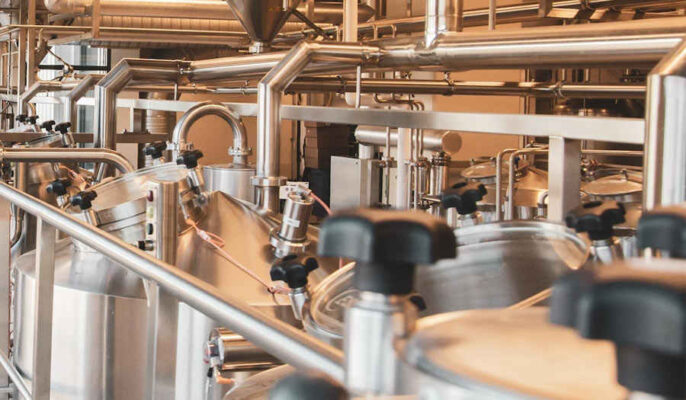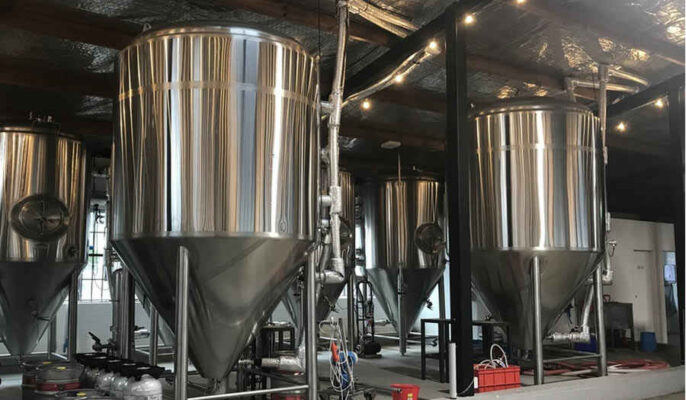Most of the people we talk to about opening a brewery already have some brewing experience. They may be a home brewery looking to go pro, or they may be developing a nano brewery into a production business. In either case, the brewery can be divided into two main parts. The first is the brewery, this is where the first stages of brewing are completed, from grinding to mashing, and from boiling to cooling the wort. The second part is the cellar. This is where fermentation, conditioning, dry hopping, and everything else that happens turning wort into beer happens. With a few exceptions, most brewery equipment falls into one of these two sections.
Brewery system type
Infusion brewery system
Infusion brewery systems are the simplest and most used type of brewery equipment. They are related to the mash tun vessel where the mash process takes place. A steeping mash system works by adding hot water to the malt to achieve a specific temperature range for enzyme activity and starch conversion. Temperature is maintained by direct heating methods such as steam jackets or electrical elements or by incorporating separate heating vessels.

RIMS (Recirculating Infusion Brewery System)
RIMS or Recirculating Immersion Brewing Systems use a combination of mash tuns, heating elements and recirculating pumps. The working principle of RIMS involves the continuous recirculation of the mash through a temperature-controlled heat exchanger. Recirculation ensures uniform heating and enzyme activity, resulting in efficient starch conversion. This method allows brewers to maintain consistent temperatures throughout the mashing process.
HERMS (Heat Exchange Recirculation Brewery System)
HERMS (Heat Exchange Recirculating Brewing System) also employs a mash tun, heating elements and heat exchangers. But, unlike RIMS, HERMS works by transferring the mash into a separate vessel (called a hot pot) where the heat exchanger is located. The hot water tank contains hot water which is circulated through a heat exchanger to maintain the desired mash temperature. This indirect heating method minimizes the risk of scorching the grains and allows for precise temperature control.
Automatic brewing system
Automated systems save a lot of labor in the brewing process. There are many options on the market with varying degrees of automation. The automated system does it all for you. You press a few buttons. The less automated the system, the more you have to do it yourself. This might be adding grains, adding hops, filling the beer into a fermenter or packaging it in kegs or bottles.
Types of Brewery Equipment
Small brewery equipment
Microbrewery equipment is designed for small breweries, producing a limited amount of beer for local consumption. These breweries specialize in brewing unique specialty beers.
Home brewing beer bar equipment
Brew bar equipment is tailor-made for establishments where beer is brewed on site and served with food in a restaurant or bar environment. The brewpub offers patrons the opportunity to enjoy fresh beer with their meal.
Commercial Brewery Equipment
Commercial brewery equipment is suitable for large-scale production and distribution of beer. These breweries produce large quantities of beer for widespread retail distribution.
Home brewing equipment
Home brewing equipment caters to brewing enthusiasts who take up brewing beer at home as a hobby. These settings are smaller in scale but allow for creativity and experimentation.
Brewhouse Equipment
Mashing/Lauter Barrel: Carry out mashing, lautering and sparging in the same vessel to save space and time. If you plan to use step mashing, you will need to use heat.
Boil Kettle/Whirlpool: A common space-saving device that requires two outlets, one to transfer the clarified wort to the heat exchange unit and the other to empty the kettle at the end of brewing.
Mash/boil kettle: With this system, you mash the mash, then transfer the mash to a separate lauter tun, and then return the sweet wort to the original vessel for boiling. An cheap method that saves space and allows for step-by-step mashing. The potential disadvantage is that you have to remove any remaining grains very before returning the wort to the boil.

Beer fermentation tank types
Most common types:
- Conical fermentation tank
- Flat bottom fermentation tank
- Conical fermentation tank
- Open fermentation tank
- Horizontal bearing box
Factors to consider when choosing brewery equipment
- When selecting brewery equipment, it is crucial to determine batch size and production capacity. Balancing current needs with future growth potential is critical.
- The choice of materials and construction affects the durability and maintenance requirements of the equipment. Stainless steel is a popular choice because of its longevity and resistance to corrosion.
- Efficient heating and cooling systems are critical to maintaining precise temperatures during brewing and fermentation.
- Automation can simplify the brewing process, but it is crucial to strike a balance between automation and manual control based on your brewing philosophy.
- Budget considerations are very important when investing in brewery equipment. Balancing quality with affordability is critical to long-term success.
Summarize
Brewery equipment is necessary for every successful beer brewing operation. By understanding the components, types, and factors to consider when selecting equipment, brewers can pave the way for a thriving and innovative brewing business. Micet is a one-stop shop for all your beer production needs. With customized services to meet your equipment needs.




